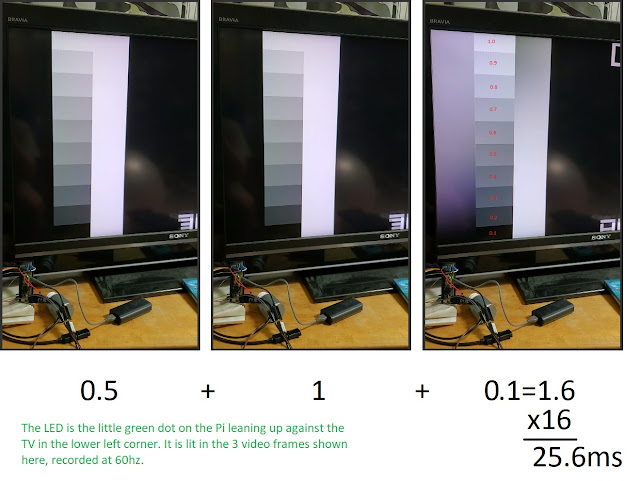LG 47LW6500-UA review: input lag and upscaling tested using the piLagTesterPRO
This 1080p LCD from 2012 has a very nice picture and supports 3D using passive polarized glasses. And it's even a smart TV. But it has a dirty secret: the worst input lag I've ever seen.
Overview/Image quality
At native resolution this TV looks great. Pixel perfect (no clipping/aliasing), as you would expect. It also does well upscaling lower resolutions: 480p/i is shown with zero aliasing or scaling artifacts, at the cost of a minor amount of cropping around the edges; roughly 15 pixels are hidden on each edge. This is very good. 720p is also very good, with zero cropping. It does introduce a slight wiggle to straight lines but it's not very noticeable, and there's no blur or other aliasing. Check out the photo at right for an example.
It can sync to both 60hz and NTSC (59.94hz) inputs, but despite loudly claiming in their marketing material that it is a 240hz display, you cannot go a single Hz above 60. Not even 70hz pc display modes work. Shame on you LG marketing department. I think by 240Hz they mean they insert a lot of black frames, but who knows.
It has all the regular inputs: HDMI, Component, etc. I tested over HDMI.
Input Lag
This display has a game mode, which I used. It did improve input lag. I toggled all the other display quality settings and did not see a consistent effect on lag. I used a piLagTesterPRO (click for full details) to measure input lag. Starting from a black background it sends a white frame of video over HDMI and measures how long it takes to show it relative to when that frame started (thus, there is more lag at the bottom of the screen than at the top).
Test Results
I report two kinds of values. 1st response measures how long it takes for the TV to start responding (I use a 5% change in display brightness). This overly optimistic value doesn't tell how long it takes to see anything useful, but matches what other reviewers call input lag. full response is a more realistic measure of lag, and requires the display to reach 80% of it's final brightness. This combines both input lag and response time, and is closer to what you would actually experience in a game.
Full results for this display
This TV is shockingly slow, and not at all what I expected for a "240Hz" display. I had to triple check that it had game mode on. 480i/p are particularly bad, at around 135ms. Somewhat surprisingly, the lag is the same whether it's interlaced or progressive, suggesting that the TV might treat them identically (i.e. try to deinterlace 480p). Or maybe with that much lag there's plenty of time to also deinterlace. I couldn't see any evidence of deinterlacing artifacts in either mode.
Things get better with HD content, dropping to 66ms of lag, but that's still worse than any other display I've tested in game mode. The only bright points are the scanout time, which is significantly shorter than the refresh rate of the display, meaning that once it finally starts drawing it does so faster than it receives the signal, and it's super fast response time of around 2ms. In fact I think this super fast response time is probably what ruins the TV: in order to drive the pixels to their final appearance that fast the TV needs to know what the next few frames are going to be, and that's why the lag is so bad.
If this were an active shutter goggle 3D display, that kind of response time would be necessary in order to switch what's being shown to each eye every 16ms. But since it uses passive polarization there's no need: every other line has an opposite polarization, allowing glasses which are permanently polarized to split the screen between eyes with zero flicker. So there's no need for such high switching speed. Perhaps LG's engineers started making a panel for active shutter goggles and switched to passive polarization later on? FYI the 3D effect this gives is very good, not that there's any new 3D content to watch anymore.
From the marketing blurb:
- See sports, video games and high-speed action with virtually no motion blur and in crystal clarity with LG's TruMotion 240Hz technology
Just to be clear, TruMotion was off, as that could have explained the huge delay too.
Just for laughs I also tried measuring the display with game mode off. The 1st response at the top of the screen was 177ms for 480i, meaning game mode is 40ms faster! On most sets that would be a significant improvement. 1080p was 75ms outside of game mode, which was a much smaller 9ms change. So game mode does something but only really for low resolution (or interlaced?) content. Obviously not enough.
Next let's compare it to other display's I've tested, just to see how bad it is.
Results Compared to other displays
Legend: Min lag is the 1st response at the top of the screen. Real lag is the full response at the bottom.
It does have the fastest response time and scan out I've ever seen, but what's that worth when the base input lag is so slow? Nothing at all.
Conclusion
In any case, worst gaming TV ever. By a huge margin. Nice 3D TV if you can find some content for it. And it looks perfectly nice for non-interactive content. It does a great job of upscaling 480i/p, if you have some old movies to watch.
Other models (to avoid)
I tested the LG 47LW6500-UA model, which is the 47" size. There were two other sizes sold with exactly the same specs: 55LW6500 and 65LW6500. I would expect them to be just as awful as this one in terms of input lag.




Comments